Demystifying near-Earth asteroids
Space is vast, but Earth is not alone. Hundreds of thousands of objects known as near-Earth asteroids (NEAs) regularly come close to our planet’s orbit. These NEAs come with a variety of physical properties, from solid rock to boulder-strewn rubble piles to dusty fluff balls.
Knowing the physical properties of these small worlds is important for both scientific reasons and planetary defense, the effort to protect our planet from hazardous asteroid impacts.
Asteroids are leftovers from the disk of dust and gas that formed the planets. Studying them teaches us more about the early days of the Solar System and how it evolved over time. Some of these asteroids may have brought water and organic materials to Earth long ago.
There’s a more practical reason for learning about near-Earth asteroids: the information could help us deflect one on course for Earth. NASA’s DART spacecraft successfully showed how we might do this in 2022 when it slammed into asteroid Dimorphos. Different deflection techniques could be needed for different kinds of asteroids, which is why we need to learn more about their physical properties.

It usually takes a space telescope or a spacecraft mission to uncover an asteroid’s physical properties. Researchers at the University of Belgrade, Serbia are working on a way to determine what asteroids are made of without leaving our planet. Their project, Demystifying Near-Earth Asteroids (D-NEAs), will use mathematical modeling to determine an important surface property called thermal inertia for as many as 150 NEAs. If successful, this modeling technique would give scientists a new way to demystify NEAs.
The Planetary Society awarded $45,000 to the project through our STEP Grants program in 2022. The project is led by Bojan Novaković of the University of Belgrade, with co-investigators Dušan Marčeta, Marco Fenucci, and Debora Pavela. The funds are being used to support faculty and students and to acquire a powerful high-speed computer on which to run computationally intensive mathematical models.
How it works
An asteroid’s surface absorbs sunlight and warms up. As the surface rotates away from sunlight, the heat radiates back into space, giving the asteroid a small push. Over time, these small pushes can change an asteroid’s orbit, a measurement known as Yarkovsky drift, named after the engineer who first described the phenomenon in 1901.
What is the Yarkovsky effect? This video by NASA's OSIRIS-REx mission explores how sunlight can change the orbits of small asteroids, a phenomenon known as the Yarkovsky effect.Video: NASA / OSIRIS-REx team
Yarkovsky drift is being measured for an increasing number of NEAs. Knowing an asteroid’s Yarkovsky drift is vital for planetary defense, since it can mean the difference between an asteroid missing or hitting Earth.
The D-NEA project will use these Yarkovsky drift values for another purpose: to mathematically derive a key property called thermal inertia. Thermal inertia is a representation of an asteroid surface’s resistance to temperature change. With this information, scientists can estimate whether the upper portion of an asteroid is made of solid rock, loose boulders, pebbles, or dust.
The D-NEA project’s goal is to derive thermal inertia values for as many as 150 NEAs. For the limited set of NEAs that have thermal inertias already determined — mostly by spacecraft observations — D-NEA modeling will try to determine the approximate densities of the asteroids. This information will demystify NEAs even further, helping us defend our planet from possible impacts.
Reflections from the team
Bojan Novaković, principal investigator:
"The probability of a near-Earth asteroid hitting the Earth is low. However, the devastating consequences of such an impact suggest that we should carefully study and understand their properties and trajectories. Our approach is based on an alternative method to characterize the surface thermal properties of those objects and fills the gap in our current knowledge of near-Earth asteroids.
The support from The Planetary Society means a lot to us. It has provided us with vital funding that enables us to continue this exciting research. Maybe a key benefit of this grant is its flexibility, which allows us to cover costs that other funding sources cannot. In particular, we would like to take advantage of the opportunity to involve students at different levels in the project."
Marco Fenucci, co-investigator:
"Studying near-Earth asteroids is really exciting, because there is so much we don't know about them. The recent space missions to Bennu and Ryugu found surprising properties that scientists did not expect before arriving there. Our Demystifying Near-Earth Asteroids project was inspired by unexpected thermal inertia results of a super-fast rotating NEA that we found in one of our previous works. We are thankful to The Planetary Society for their support, which allowed us to pursue our research on this topic and to make it visible to the scientific community."


 Explore Worlds
Explore Worlds Find Life
Find Life Defend Earth
Defend Earth

